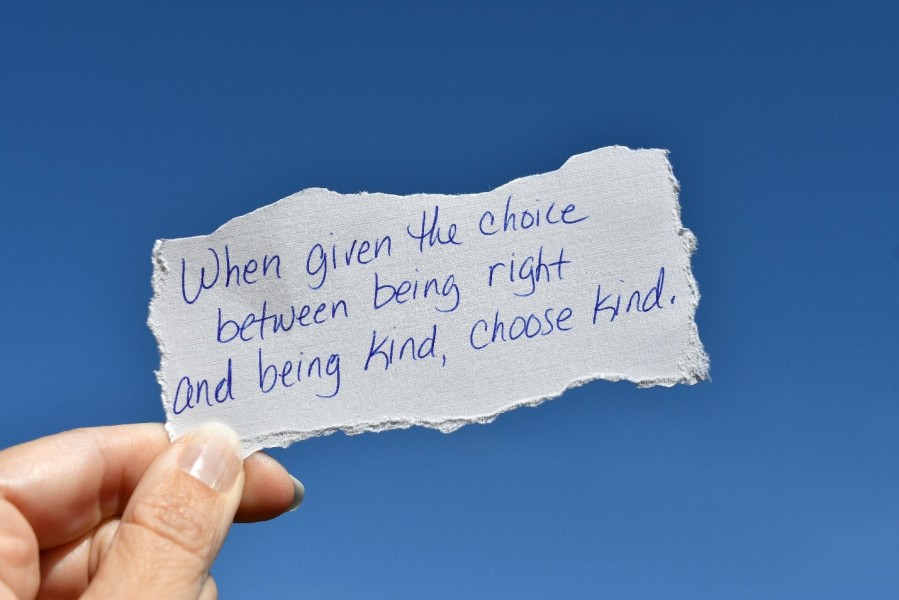Practicing kindness at work is essential to attracting emerging talent

As someone who first joined corporate America over 30 years ago, it’s been gratifying to witness the demise of certain antiquated beliefs along with the predominance of the fax machine and pantyhose sold inside an egg-shaped container.
Ideas like:
- The world will end if you ever cry in the office.
- You must constantly be, look, and sound perfect—or you’ll never get ahead.
And—a belief which was popularized by various Wall Street “Masters of the Universe” and Enron-esque “Smartest Guys in the Room” stereotypes:
- Showing kindness is a weakness.
While the first two examples focus on being your authentic self at work, (a topic I’ve written and spoken about frequently) the third focuses on the shift in how kindness is perceived. This last is particularly insightful, highlighting the metamorphosis which corporate culture has undergone as of late. These days, practicing kindness – which involves treating others with mutual respect, compassion and promoting inclusion – is “table stakes” in creating a high-performing organization.
The Brand Marketing Blog defines table stakes as “the minimum offer to be considered a viable player, whether you are at the poker table or the boardroom table.” That means you aren’t getting extra credit for being kind and caring about employees; it is expected.
An Evolving Perception
David Lancefield, a CEO Catalyst, Strategist and Coach, has seen a major shift in how kindness is perceived in the workplace over the past few decades.
“People known for being kind used to be perceived as those on the sidelines who aren’t really busy; they’ve got time for kindness,” he explains. “The expectation for kindness as normal is now ingrained in people younger in spirit and of age. In many cases you look at elder millennials, they’re becoming the CEOs, they’re running organizations for everyone to succeed and thrive. If you want to recruit this talent, there’s a lot of pressure on a whole group of leaders who didn’t grow up with it to change.”
Lancefield feels that kindness at work inherently refers to compassion. In his work with numerous global organizations, he has observed that a mindset of kindness fosters connections between people, dialogue, discussion, debates, imagination, and exploration.
“You thought about somebody’s else’s feelings, that’s empathy, and you are going to try and do something about it. Compassion has the action element to it,” he added. “There’s a sort of selflessness to it in helping others in times of difficulty. You were kind because you gave someone on your team time to talk through a difficult issue in their team or a problem at home.”
Essential for Emerging Talent
As more Millennials are taking senior leadership roles and Gen Z individuals enter the workforce, there is a growing expectation for companies to practice compassion and kindness as a core part of their culture.
Millennials, those born between 1981 – 1996, currently comprise the largest percentage of the workforce. Having a positive culture matters a lot to this demographic. According to the most recent Great Place to Work annual survey, the Top 5 Things Millennials Want in the Workplace in 2022 includes purpose and a healthy work-life balance, which encompasses “feeling their workplace is psychologically and emotionally healthy.” A culture where kindness is the norm goes a long way to meeting that need.
Generation Z, individuals born between 1997 – 2012, also place a high value on compassion and kindness. Global speaker, author, and M&A expert Jennifer Fondrevay saw this on full display at her son’s high school graduation in May, and it filled her with hope.
“My experience was if you’re kind at work, people assume you’re clueless, a chump, don’t get it, aren’t savvy to what’s really going on. A general scroll through social media could convince you that “niceness” is being replaced by “snarkiness” as the key survival tactic. That’s what I feared, until my son’s graduation ceremonies renewed my faith in humanity,” she said.
“That ceremony, filled with smart and talented kids, didn’t focus on the great colleges they’re going to. They talked about the value of showing compassion, empathy, and kindness to one another. That, more than anything, helped them look forward to the future.”
“They’re not ashamed to openly talk about their struggles – and more importantly, equally focused on helping one another get through those struggles,” she concluded. “If these kids are any indication of the kind of people who will be entering the workforce in four years, the world will be a better place.”
Ideally, you want to encourage employees of all demographics to embrace a kinder culture. Leadership modeling that behavior will help, as does talking openly about the concept as a corporate value. Educating people about the difference between being kind and nice can help too.
Distinguishing Between Being “Kind” and “Nice”
It can be easy to confuse the terms “nice” and “kind.” Nice, which is typically defined as being pleasant and agreeable, can stem from an individual having their own agenda. They are helpful to you because they expect to receive that courtesy in return. Kindness, though, has an element of selflessness. You are practicing that behavior because it is the “right” thing to do in helping individuals, a team, or your organization overall.
Andie Herbert, Founder & Chief Kindness Officer at culture transformation consultancy Be Kind Lyfe, eloquently explained the distinction to me when we spoke. “Being nice can sometimes lack authenticity because a person can be pleasant to your face but dislike you behind your back. However, kindness is really three principles—empathy, curiosity, and grace,” she said.
“Empathy allows people to understand where you are coming from and what is driving their decision-making,” she continued, noting that empathy is easy with people who agree with you, and the real work is understanding people who have opposite opinions. “Then we move to curiosity in a non-judgmental way to truly understand where a person is coming from. Finally, we have to have grace with ourselves and others for mistakes. If we as leaders are accountable for our mistakes, our teams are not going to be scared to raise their hand, say I messed this up, and ask for help.”
Leadership expert Amanda Gibson further elaborates on this concept. She says that individuals sometimes default to saying something nice because they don’t know what else to say, whereas kindness has intention behind it.
“For me, nice is transactional, short-term, ‘do what comes easiest’ or seems most acceptable in the moment. It can often be about minimizing discomfort or maintaining a certain appearance of being a nice person,” she noted. “Whereas kind is more intentional, about ‘do what is needed’ in the moment. Kindness is oriented at what benefits and impacts others, and often requires more reflection around the kind of person you want to be and what will be meaningful to others. It takes a long-term view and is not based on your automatic reaction or desire to be seen a certain way in the moment.”
Embrace Kindness at Work
Anyone can embrace more kindness at work. The rewards of doing so are tremendous. “A mindset of kindness helps you create high performing organizations where people have great opportunities to make an amazing impact in their society while delivering fantastic share value,” added Lancefield. “Kindness is a great vehicle for people to share more of themselves, do great work and make stronger connections between people.”
Tip: The next time you practice kindness at work, pause for a moment and consider if it is about others around you or yourself. Be honest about your motivation and consider how to have the best possible impact on the individual(s) you’d like to engage with, recognize, or support.
Looking for a step-by-step process to help you get unstuck and stay that way for good? Check out Free and Clear: Get Unstuck and Live the Life You Want. It is chock-full of helpful tips, easy-to-use tools and inspirational stories of individuals who overcame obstacles against the odds.
